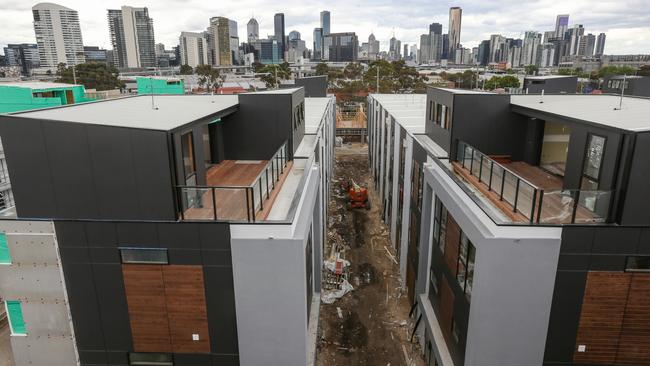Westpac chief Brian Hartzer: unit prices high but no bubble
Westpac boss Brian Hartzer has conceded apartment prices in Sydney and Melbourne are “very high”.

Westpac boss Brian Hartzer has conceded apartment prices in Sydney and Melbourne are “very high” as he played down fears of a speculative housing bubble, despite analysts warning rampant investor lending in the shadow banking market could prompt further regulatory crackdown.
Mr Hartzer, the last of the big four bank chief executives to front the House of Representatives committee for questioning this week, stressed Westpac’s “granular” level of risk monitoring, saying the bank knew its exposure to “literally” every building in Australia and that he receives an email each week on the presales progress of individual buildings. He said there was a “distinction between a speculative bubble in prices and prices that are beyond what the fundamentals would justify”.
Mr Hartzer said “a credit-fuelled speculative bubble” was characterised by people quickly buying and selling properties in the hope of ever-increasing prices, while “what we’re seeing in Sydney and Melbourne is the consequence of severe supply constraints running into a significant step up in demand — albeit that’s attenuating a little bit now — from offshore buyers”.
While Westpac will still fund high-quality buildings designed for local buyers, such as those apartments in Docklands, Melbourne, Mr Hartzer said “you can go half a dozen blocks away and find another apartment building with a very small footprint, targeted at overseas buyers who don’t plan to live there and it’s in trouble”. Since China clamped down on capital outflows, a number of developments which were pre-sold to overseas buyers are now experiencing trouble closing sales or reselling the units to locals.
“That is creating a bit of glut of supply, which may not be what the local buyers want to buy,” Mr Hartzer said. “Generally those buildings do end up clearing, it’s just taking longer.”
Prudential regulator APRA on Tuesday fired a warning shot over poor standards in the banking sector’s commercial loan portfolios. The regulator said lax data collection and poor portfolio monitoring had clouded the ability of boards and management to gauge the level of risks in their books, including in apartment lending.
With the Reserve Bank also warning that house prices were “rising briskly” and APRA boss Wayne Byres recently taking a harder stance on excessive lending to investors, analysts are now warning regulators could take further action to cool the frothy and increasingly risky market.
The most recent figures show Sydney house prices are up almost 20 per cent over the last year, while Melbourne prices are up about 13 per cent. Auction clearance rates in both major cities have surged to a record-high 80 per cent.
Worryingly, fresh research from Citi shows APRA’s investor lending growth limit of 10 per cent appears not to apply to a number of “micro-banks” which sit outside the four major banks and the second-tier regional lenders, such as Beyond Bank and Auswide bank, which are lending at rates close to 20 per cent.
Citi analyst Craig Williams said APRA may now be forced to clamp down on investor lending with harsher rules.
Previous experience in the hot property markets in Hong Kong and Auckland have shown prudential standards were increasingly ratcheted up in order to dampen investor appetite. Mr Williams said APRA could bring in a less generous investor growth limit, tighten rules for loan requirements or hit investors with a tax or stamp duty increase for “flipped” properties, where investors engage in fast-paced speculative buying and selling of homes.
Mr Williams said house prices in Sydney and Melbourne “continued to accelerate at uncomfortably high levels”, and with the share of loans going to investors running at around 40 per cent, he suggested a “significant level of activity is just pure price speculation”.
Both the Organisation for Economic Co-operation and Development and ratings agency Standard & Poor’s recently warned about the financial stability of the Australian economy and the strength of the housing market. ASIC last week launched a Federal Court action against Westpac for allegedly failing to properly assess borrowers’ ability to repay their loans.
APRA has recently been pulling banks aside before they reach the 10 per cent limit on investor loan growth, based on the trajectory of their lending. However, a number of “micro-banks” have been exceeding the limit, such as G&C Mutual Bank, where investor lending grew more than 100 per cent last year, or Defence Bank, which has grown investor lending 25 per cent.
Currently, borrowers need to prove they can withstand rate hikes of 2 per cent. Mr Williams said APRA could lift this to 3 per cent, and said it seemed “inconceivable” there were not already “very different serviceability standards” used across the market. “There is a significant risk of systemic serviceability issues in the event of high inflation,” he said.
Hong Kong managed to dramatically slow investor lending with a buffer of 3 per cent and requiring borrowers stump up half a loan’s value in a deposit. Auckland’s property market was slowed with a 40 per cent deposit.



To join the conversation, please log in. Don't have an account? Register
Join the conversation, you are commenting as Logout